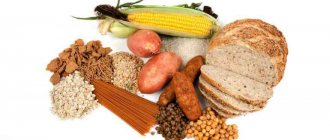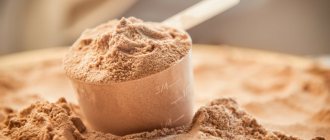What is whey concentrate
Whey protein is a source of purified protein. It is completely absorbed and consumed by the body.
Protein is used for the following purposes:
- building muscle mass;
- protein compensation during a mono-diet;
- minimizing the loss of muscle tissue during drying;
- maintaining shape and relief during training.
Protein mixtures are in demand among professional bodybuilders, weightlifters, and just sports fans. The nutritional supplement is suitable for both male and female bodies.
Composition, what it is made from
Protein is the basis of any protein supplement. One serving contains on average 25 g of protein, 4 g of carbohydrates, 2 g of fat, 400 mg of nutrients (potassium, sodium, calcium, cholesterol).
The basic components of the mixture always remain the same. Manufacturers can change the quantitative composition of microelements, add vitamins, natural or synthetic flavors.
The mixture is obtained from filtered whey. The concentrate production process can be reflected in the form of a diagram:
When milk is fermented, the curds are separated. It retains the bulk of milk protein (or casein). The remaining liquid is whey, which serves as the basis for protein.
The resulting solution is heated at a temperature of 72 degrees. The consistency goes through several stages of filtration and drying. The output is protein, ready for consumption. To improve the taste of the powder, the manufacturer adds flavorings and sweeteners.
Whey mixture is not only produced as a concentrate. Further processing of the product makes it possible to obtain a higher quality protein, practically free of fats and carbohydrates - isolate. The highest degree of processing is hydrolyzate. The product contains 99% pure protein. The disadvantages are the high price and unpleasant taste.
Which is better: whey protein concentrate or isolate?
The dried powder in the form of a concentrate contains no more than 80% protein, the remaining 20% are carbohydrates and fats. When producing whey isolate, the protein content is increased to 90%.
The differences between the two forms of whey concern not only the nutritional value of the mixture, but also the price component.
Ratio of indicators per 1 serving of product (100 kcal):
| Options | Whey Protein | |
| Isolate | Concentrate | |
| Treatment | Better quality | Minimum |
| Protein | 23 g | 18 g |
| Carbohydrates | 1 g | 3.5 g |
| Fat | 0 g | 1.5 g |
| Lactose | less than 1 g | up to 3.5 g |
| Price | High | Low |
Each type of protein has its own purpose. Whey concentrate is used more during the period of weight gain. High-protein isolate is indispensable for weight loss and cutting, suitable for people with lactose intolerance.
Protein intolerance and side effects
Whey protein is not only a valuable protein product, but also a substance that can cause unwanted reactions in the human body due to intolerance to milk and whey. This phenomenon is associated with the presence of about 20 allergens in proteins, among which the most powerful are alpha-lactalbumin, beta-lactoglobulin and lactose.
As medical statistics show, the largest number of patients with intolerance to these proteins are among infants and young children, as well as in elderly people after 60-65 years.
When consuming whey proteins, the following signs of intolerance to animal proteins may occur:
- diarrhea;
- nausea, vomiting;
- increased flatulence;
- pain and cramps in the abdomen.
However, consuming hydrolyzed, hypoallergenic forms helps reduce these side effects.
Types of sports supplements
Today, a large number of different protein complexes are produced. Powdered supplements are sold in sports nutrition departments or specialized online stores.
A wide range of products confuses novice athletes. An incorrectly selected supplement will not bring the desired effect; in some cases, the result will be exactly the opposite.
There are more than 8 types of sports supplements. The speed of achieving the goal is influenced by the type of protein base of the product.
Egg protein concentrate
The product is made from egg whites. It is a completely natural and safe supplement.
What you need to know about egg white:
- It has the greatest biological value.
- 100% absorbed by the body.
- Does not contain lactose, cholesterol, fat.
- The most expensive among all supplements.
The mixture is universal for use at any time of the day. Validity period: 3-5 hours.
Milk protein concentrate
The powder is obtained from milk. Contains 25% whey protein, the rest is casein.
Product Feature:
- Contains calcium, amino acids, minerals.
- Has a good degree of absorption.
- Not suitable for lactose intolerance.
- Reasonable price.
Use as a snack or drink at night. Duration of action – 4-6 hours.
Soy protein concentrate
Produced on the basis of plant components. Soy protein contains an incomplete group of amino acids, is poorly soluble in liquid, and has an unpleasant aftertaste.
Main advantages:
- Reduces cholesterol levels and starts metabolic processes.
- It is popular among girls as it promotes the production of female hormones.
- Suitable for vegetarians or those who cannot digest dairy products.
- Reasonable price.
Used after sports or between meals. Valid for 4-5 hours.
Milk prepared for the production of cheese does not always meet the requirements, and producers are forced to resort to various methods of improving the cheese-suitability of milk, one of which is the use of milk protein concentrates.
One of the important criteria that determines the raw suitability of milk is the mass fraction of protein, which is not stable over the seasons and depends on many factors, including feeding conditions, animal health, and livestock breed. A consistently high protein content in milk is a significant factor in producing high-quality cheese and increasing the yield of the finished product.
However, not in all regions of the country, milk prepared for cheese production meets the requirements, and producers are forced to resort to various methods of improving the cheese-suitability of milk, one of which is the use of milk protein concentrates.
At VNIIMS, as part of research work, comparative production of semi-hard cheeses and cheese products (CP) with a low second heating temperature and a mass fraction of fat in terms of dry matter of 50% was carried out, using a milk-protein mixture produced by under the brand name "Milkmix Universal".
Dry milk-protein mixture "Milkmix universal" (MBS) is a milk-protein product that contains caseinates and milk protein concentrate. The color of the powder is from white to cream; the smell is characteristic of dairy products.
The physicochemical composition of the dry milk-protein mixture “Milkmix Universal” is presented in table. 1.
The purpose of the research was to study the features of using Milkmix Universal for normalizing milk formula for protein, obtaining data on changes in the quality of cheeses and cheese products during their ripening and storage.
Table 1 . Physico-chemical composition of the mixture “Milkmix universal”
| Indicator name | Indicator value |
| Moisture content, % | 4,8 |
| Mass fraction of protein, % | 60±2 |
| Mass fraction of fat, % | 1,8 |
| Mass fraction of ash, % | 4,7 |
| Mass fraction of carbohydrates, % | 25,3 |
| Active acidity, units pH | 6,5±0,5 |
“Milkmix universal” was pre-dissolved in skim milk at a temperature of (45±5) °C, kept for (40±5) minutes and added to the milk mixture before pasteurization.
A milk-fat emulsion with a mass fraction of fat (25.0±5.0)%, composed of milk fat replacer (MFS) and skim milk at a temperature of 50 °C, after dispersion, was added to the milk mixture before pasteurization.
To produce products, three variants of the mixture were compiled, the composition of which is given in table. 2.
Table 2 . Composition of the mixtures under study.
| Indicators | Option No. 1, cheese (control) | Option No. 2, cheese (experience) | Option No. 3, joint venture (experience) |
| Mass fraction of protein in the mixture, % | 3,1 | 3,2 | 3,2 |
| Mass fraction of fat in the mixture, % | 3,2 | 3,3 | 3,3 |
| including dairy products, % of dairy | — | — | 50 |
| Normalization factor | 1,032 | 1,031 | 1,031 |
From the mixture of option No. 1, cheese was produced, which served as a control; from mixture No. 2, an experimental cheese was produced; from mixture No. 3, an experimental cheese product was produced. As functionally necessary components, a production starter was used, which included active acid and flavor formers (Lc. lactis, Lc cremoris, Lc. diacetilactis, Leuconostoc) and milk-clotting enzyme of animal origin SP-90 “Extra”. The produced cheeses and SP were ripened for 30 days and then stored for 2 months.
In cheese making, an important factor that subsequently determines the entire course of technological operations for producing cheese and biochemical processes during its ripening is the ability of the milk mixture to form a clot with certain rheological characteristics and the ability of this clot to syneresis. To obtain a curd in the production of semi-hard cheeses and cheese products, a milk-clotting enzyme preparation is used, which is a fairly expensive ingredient, accounting for up to 0.5% of the cost of the product. Therefore, the consumption of the rennet used, which was determined using a VNIIMS mug, is of undoubted interest in the experiment.
The research results showed that the amount of rennet (g) required to curdle 100 kg of milk mixture in 30 minutes in option No. 1 (control) was (average data for three repetitions) (2.37 ± 0.13) g, and in experimental variants No. 2 and No. 3 - (2.02 ± 0.12) g. Increasing the mass fraction of protein in the mixture by 0.1% made it possible to reduce the consumption of rennet by an average of 15%. In addition, in the experimental variants, a more intense process of syneresis of the clot after its cutting was noted. The duration of processing of cheese grains in the experimental variants was reduced, and the readiness of the grain for molding in variants No. 2 and No. 3 of the experiment occurred on average 15 minutes earlier than in the control (variant No. 1 without MBS). This made it possible to reduce the duration of grain processing in the cheese bath by almost 20%.
Table 3. Change in the mass fraction of moisture in cheeses and SP during ripening and storage (average data for three repetitions), %
| Option No. | Control points | |||
| After pressing | 30 days | 60 days | 90 days | |
| 1 | 46,1±0,2 | 42,3±0,2 | 41,4±0,2 | 40,0±0,2 |
| 2 | 45,8±0,1 | 42,3±0,2 | 41,1±0,2 | 39,9±0,2 |
| 3 | 43,3±0,2 | 41,7±0,2 | 40,8±0,2 | 39,5±0,2 |
The results of physico-chemical analyzes of cheeses and SP after pressing, at standard age (after ripening) and during storage are presented in Table. 3.
In option No. 3, after pressing, lower values of the mass fraction of moisture in the joint venture were noted by an average of 2.8% with a shorter duration of processing of the cheese grains in comparison with the control (option No. 1). In option No. 2, with a shorter duration of grain processing in a cheese-making bath, the mass fraction of moisture in the cheese after pressing was comparable to the control.
As the cheeses and SP were ripened and stored, the values of the mass fractions of moisture in all experimental variants differed from the control by no more than 0.5-0.6%.
For a comparative assessment of the quality of the finished product and its storage capacity, the dynamics of the active acidity of the cheese mass during ripening and storage is of great importance. The observation results are presented in table. 4.
Table 4. Changes in active acidity in cheeses and SP during ripening and storage (average data for three replicates), units. pH
| Option No. | Control points | |||
| After pressing | 30 days | 60 days | 90 days | |
| 1 | 5,3±0,01 | 5,1±0,02 | 5,1 ±0,01 | 5,2±0,01 |
| 2 | 5,4+0,01 | 5,1 ±0,01 | 5,1 ±0,02 | 5,2±0,01 |
| 3 | 5,2±0,01 | 5,1±0,02 | 5,2±0,01 | 5,2±0,02 |
Analyzing changes in active acidity in cheeses and SP during production, ripening and storage, it should be noted that the pH values practically did not differ between the experimental variants. Nevertheless, the greater buffer capacity of the cheese mass with MBS can be judged on the basis of subsequent organoleptic examination, when, while the physical and chemical parameters (moisture, pH) were identical, the presence of self-breaking cracks was revealed in the control sample (see photo). They were absent in the prototypes (options No. 2 and No. 3). The presence of self-breaking cracks indicates the accumulation of excess lactic acid, which in free form splits off calcium from the paracaseinate calcium-phosphate complex, reducing the cohesion of the cheese mass, which during the ripening period with the development of gas-forming microflora leads to splitting of the cheese mass.
To objectively assess the consumption of the mixture and the yield of the finished product, using formulas (1) and (2), the mass fraction of moisture in cheeses and cheese products of all options was unified to 45.0% and the coefficient of utilization of dry substances of the milk mixture was determined.
Bringing cheeses and SP to the same mass fraction of moisture (45%) to compare the product yield was carried out according to the formula
where M45% is the mass of cheese or joint venture reduced to a mass fraction of moisture equal to 45%, kg; Mpr - mass of cheese or joint venture after pressing, kg; B is the mass fraction of moisture in cheese or SP after pressing, %.
Determination of the coefficient of utilization of dry substances of the milk mixture was carried out according to the formula
where SVpr is the mass fraction of dry substances in cheese or SP, %; Mpr - mass of cheese or joint venture after pressing, kg; SVsm - mass fraction of dry substances in the mixture, %; Mcm is the mass of the mixture, kg.
The calculation results are given in table. 5.
Table 5. Mixture consumption and coefficient of use of dry substances of the milk mixture for the production of 1 kg of cheese and SP (average data for three repetitions)
| Indicators | Option #1 | Option No. 2 | Option No. 3 |
| Mass of the mixture in the bath, kg | 205,0 | 200,3 | 203,5 |
| Mass fraction of dry substances in the mixture, % | 11,80 | 11,90 | 11,95 |
| Cheese weight, kg | 20,80 | 22,70 | 21,95 |
| Mass fraction of cheese dry matter (100-B), % | 54,1 | 54,0 | 56,7 |
| Weight of cheese mass fraction of moisture 45.0%, kg | 20,50 | 22,25 | 22,65 |
| Mixture consumption per 1 kg of product, moisture mass fraction 45%, kg | 10,00 | 9,00 | 9,05 |
| Dry substances utilization coefficient of the mixture, % | 0,465 | 0,515 | 0,515 |
From the data in table. Figure 5 shows that when adding MBS to increase the mass fraction of protein in the milk mixture by 0.1%, the consumption of the mixture to produce 1 kg of product decreased by an average of 10%. The average consumption of the mixture in option No. 1 was 10.0 kg per 1 kg of cheese; the average consumption in options No. 2 and No. 3 was 9.0 kg per 1 kg of cheese and SP.
The degree of utilization of milk solids with the addition of MBS increased by 10.7% - from 46.5% (control without MBS) to 51.5% (experiment with the addition of 0.1% MBS).
Organoleptic examination of cheeses and SP was carried out immediately after reaching the standard age (30 days) and then for 2 months. storage with a control frequency of 1 month.
The maximum score for taste and smell (average score 38.3) was obtained by the cheeses of option No. 2 (experiment). The advantages of these cheeses were a pronounced cheese taste and cheese aroma. In second place in the number of points for taste and smell (an average of 37.8 points) were SP option No. 3. They had a moderately pronounced cheese taste with a slight hint of foreignness. Control cheeses (option No. 1) received the lowest number of points (an average of 37 points). The main devaluing characteristics were a less pronounced cheesy, more sour taste. This pattern was typical for all repetitions of the experiment.
The score for the consistency of cheeses and SP ranged from satisfactory (23 points) to good (24 points). But since the cheeses of option No. 1 in one of the repetitions of the experiment received an unsatisfactory rating (20 points) due to the appearance of self-propelled cracks, the average rating of these cheeses also turned out to be lower (21.5 points) compared to the experimental samples (an average of 23. 75 points).
During the maturation process, protein proteolysis occurs, which is characterized by the breakdown of the protein molecule and its transition from an insoluble to a soluble state. Soluble nitrogen compounds in cheeses correlate with cheese flavor and aroma, so total soluble nitrogen and non-protein nitrogen compounds were examined in cheeses and SP.
Conventionally, the “width” of proteolysis was expressed by the ratio of the content of water-soluble nitrogen to the content of total nitrogen (Table 6). The “depth” of proteolysis was characterized as the ratio of soluble non-protein nitrogen to total soluble nitrogen (Table 7).
From the analysis of the data presented in table. 6, 7, it follows that the intensity of proteolysis, measured by the content of soluble non-protein nitrogen as a percentage of total soluble nitrogen in the experimental variants (No. 2 and No. 3), is significantly different from the control (variant No. 1). Non-protein nitrogenous compounds include amino acids and short-chain peptides, which characterize the degree of expression of cheese taste.
Table 6. Ratio of total soluble nitrogen to total nitrogen, %
| Option No. | Control points | ||
| After pressing | 30 days | 60 days | 90 days |
| 1 | 19,5 | 20,9 | 22,1 |
| 2 | 21,3 | 21,1 | 21,4 |
| 3 | 15,7 | 16,8 | 20,5 |
Table 7. Ratio of non-protein nitrogen to total soluble nitrogen, %
| Option No. | Control points | ||
| After pressing | 30 days | 60 days | 90 days |
| 1 | 34,7 | 39,3 | 44,0 |
| 2 | 34,7 | 45,1 | 54,1 |
| 3 | 46,9 | 62,2 | 54,6 |
The conducted research shows that when using the milk-protein mixture “Milkmix Universal” in an amount of 0.1% to normalize the mixture for protein in the production of semi-hard cheese and cheese product with a low second heating temperature, the following results were observed: The data obtained are consistent with an increase in the degree of expression of the cheese taste in cheeses and cheese products of options No. 2 and No. 3 with the addition of MBS compared to cheeses of option No. 1.
— the amount of rennet for coagulating milk mixture decreased by an average of 10%; the duration of grain processing in a cheese bath was reduced by an average of 20%;
— the degree of use of dry substances in the mixture increased by an average of 10.7%; the mixture consumption for producing 1 kg of product decreased by an average of 10%;
— the degree of expression of the cheese taste and aroma of the experimental cheeses and cheese products increased compared to the control variant.
In addition, the results of the organoleptic examination confirmed the better storage capacity of cheeses and cheese products of the experimental variants in terms of organoleptic indicators.
Literature:
1. Gudkov A.V. Cheese making: technological, biological and physical-chemical aspects / A.V. Gudkov. - M.: Delhi print, 2003. - 779 p.
2. Trukhachev V.I. Milk protein concentrates: isolation and application / V.I. Trukhachev, V.V. Molochnikov, T.A. Orlova, RI. Ramanauskas. - Stavropol: AGRUS, 2009. - 152 p.
V.A. Mordvinova, Ph.D., I.L. Ostroukhova, Ph.D., FGBNU "VNIIMS"
№3 2020 Magazine MILK PROCESSING
Original article -
Best Whey Protein Concentrate Brands
Despite the variety of products, there are certain brands that are preferred by sports enthusiasts.
The popularity rating of a product depends on a number of important indicators:
- quality of the finished product;
- main purpose of the impurity;
- speed of absorption;
- price.
Top 5 brands of whey concentrates:
| № | Name | Manufacturer | Peculiarities | Approximate cost (RUB) |
| 1 | 100% Whey Gold Standard | Optimum Nutrition USA | Market leader. Easily digestible, even if you are lactose intolerant. Contains aminogen and lactase enzymes. Tastes good | 1800 |
| 2 | KSB 55 | KSB Belarus | Includes a complete set of amino acids. Good combination of price and quality. Good for starting | 990 |
| 3 | 100% WheyProtein | Hungary Scitec Nutrition | Contains a small dose of carbohydrates and fats. Ideal for weight loss, improves muscle anabolism | 1100 |
| 4 | Prostar 100% Whey Protein | Ultimate Nutrition USA | Contains up to 83% protein, the number of other fillers is minimized | 1400 |
| 5 | 100% Pure Titanium Whey | SAN USA | Represents a mixture with isolate. High-quality composition and good taste characteristics | 1700 |
Summarize
- Whey protein is made up of several fast-digesting proteins and is a common ingredient in dietary supplements. The two common forms are whey isolate and concentrate.
- Whey protein isolate undergoes different processing compared to concentrate, resulting in more protein and less carbohydrates and fat per serving.
- However, these nutrient differences are small and there is no proven difference in the effectiveness of the two types of whey protein.
- Whey isolate can be a good choice for those who carefully limit their intake of fat, carbohydrates, or lactose, although this form of whey protein tends to be more expensive.
- Taking a slightly higher dose of whey protein concentrate can result in the same amount of high-quality protein as taking a smaller amount of whey isolate, but often at a lower cost.
- No matter what type you use, whey is a high-quality protein that can help you reach your daily protein goals.
Tags: Protein
- Related Posts
- 7 signs and symptoms of magnesium deficiency in the body
- Epigallocatechin gallate (EGCG): properties, dosage, side effects
- How to Increase HGH Production Naturally
« Previous entry
When and How to Take Whey Protein Concentrate
To increase training productivity, the supplement must be consumed within a certain period of time. The greatest effectiveness is achieved with rational use of the powder.
In the morning hours
Goal: prevent the processes of muscle fiber breakdown.
Without receiving energy during the night, the body begins to use up glycogen and amino acid reserves. In addition, in the early hours the hormone cortisol is produced, under the influence of which muscle tissue is destroyed. A morning dose of whey protein prevents destructive processes.
Before training
Objective: obtain a sufficient amount of amino acids.
The composition is drunk half an hour before pumping. The energy drink allows you to successfully conduct intensive training and prevent muscle catabolism.
Upon completion of the lesson
Purpose: rapid weight gain.
Protein is best absorbed in the first hours after intense activity. Protein instantly enters the bloodstream and ensures rapid growth of muscle fibers.
The powder can be combined with any beneficial ingredients and dissolves in liquid drinks. To reduce calories as much as possible, it is better to dilute the mixture in plain water.
Milk protein, sources, benefits and harms
Dairy products play an important role in the human diet. This is due not only to the presence of important microelements and vitamins in them, but also to the content of unique proteins that help maintain normal health. In addition, milk protein can be a good alternative to meat protein if you cannot afford this product or are a vegetarian.
Features of milk protein
Milk contains two main types of protein. These are whey protein and casein. The amount of the latter predominates, since it occupies 80%-90% of the total mass of the product. Regarding whey proteins (albumin and globulin), it can be said that their amount increases significantly in concentrates that are used to prepare a number of fermented milk products. In particular, for the production of rennet cheeses.
The peculiarity of whey protein lies in its amino acid composition. The branching of protein molecules creates favorable conditions for their effective absorption by the body in general and muscles in particular. Whey protein is considered the most balanced in terms of amino acid content.
In contrast to the above component, casein is processed by the body much longer, which is due to the need to maintain a constant flow of amino acids into the blood, which are important for organizing connections in cells. When contacted with acid, casein coagulates, which allows the creation of fermented milk products. It should be noted that in its pure form this substance is insoluble in water, however, when combined with calcium, that is, before the inclusion of acid in the composition, casein is highly soluble.
Due to the peculiarities of their composition, milk proteins combine well with proteins of a different structure - meat and vegetable ones. They can be used to prepare gravies served with poultry and fish dishes, for stews with legumes, or in combination with the use of soy equivalents of a healthy product.
Milk protein sources
Direct sources of milk protein are milk itself and fermented milk products. They have a valuable protein component, but, in addition, they are also valued for their easily digestible calcium. Based on these indicators alone, dairy products can be called one of the main components of the human diet from the first days of life!
Sources of milk protein are cheeses, rennet, hard cheeses, cottage cheese, yogurt, sour cream, kefir, yogurt, kumiss.
The relatively inexpensive and accessible range allows you to enrich your diet with valuable amino acids without the cost of meat. In addition, such protein is much easier to digest and therefore is an order of magnitude healthier than proteins of a more complex structure, which include beef, chicken, turkey, beef, eggs and other products.
Thanks to a number of beneficial properties, white milk should definitely be included in every person’s diet!
Benefits of milk protein
The benefits of whey protein and casein can be considered separately.
Whey protein is quickly absorbed and the nutrients it carries with it quickly enter the body's tissues, including muscles. This allows you to quickly replenish energy costs and improve metabolic processes designed to normalize the functioning of organs and systems.
Whey protein is closest to the amino acid composition of muscle tissue, so it can improve muscle recovery processes. This fact is especially relevant for those who are actively involved in sports. Fermented milk products will help reduce muscle pain and normalize regeneration processes in tissues.
Regular consumption of whey proteins allows you to speed up the process of fat breakdown, which promotes more intensive weight loss without loss of muscle mass. Particular attention to this property should be paid to those who want to get rid of fat on the stomach, sides and thighs, that is, in the most problematic areas.
Another useful property of these amino acids is the normalization of the production of cholesterol and special blood proteins that participate in the body’s lipid metabolism and increase the sensitivity of cells to insulin. This helps reduce the amount of sugar in the blood and improve its composition in general.
Whey proteins are also believed to help reduce overall levels of irritability and control yourself in stressful situations. This occurs by decreasing cortisol production and increasing serotonin production. This same factor has a positive effect on the body’s ability to sleep productively and rest.
Casein takes longer to digest, but its role in the body is different. Unlike whey proteins, it promotes tissue nutrition not in the short term, but in the long term, which is very important during intense physical activity, hard monotonous work and high intellectual activity. Useful protein is absorbed gradually, transferring important substances to those organs and tissues that most need building material, and precisely at the moment when it is most needed. The effects of casein last for six hours after consuming dairy products. In a sports environment, it is customary to use them at night, since during this time period the body is actively recovering, which requires essential amino acids. Athletes who want to build muscle mass can consume cottage cheese or yogurt at night. This method is especially effective if you train for at least two hours daily.
When milk protein, casein, combines with acid in the stomach, it coagulates and requires more enzymes for digestion. This increases the processing time of the substance, which causes a prolonged feeling of fullness. This factor is useful for those who want to lose weight. Dairy-based snacks, including milk-based cereals and soups, are excellent nutritious meals that support normal digestion and help keep you from eating unhealthy foods throughout the day.
Separately, it is worth noting the benefits of milk protein for digestion, normalization of metabolism and cleansing of the body. In this sense, dairy products are irreplaceable, since other types of proteins act more harshly on the gastrointestinal tract and are not suitable for everyone.
Whey Protein for Muscle Growth
To build muscle, your daily calorie intake must exceed your calorie expenditure. The amount of protein needed per day depends on the person’s constitution: people with a thin build require less product, those predisposed to obesity require more. The average norm is 1.5-2.6 g per kilogram of weight.
To pump muscles, the mixture is consumed 2 times a day. The appropriate period for taking a portion is the first half of the day and immediately after the end of the strength training. Exceeding the dosage is not recommended.
On non-training days, protein is consumed in the morning or instead of a snack.
What can you replace whey protein with?
The beneficial component is found in many natural products that people consume in everyday life - milk, butter, yogurt, cheese. Whey protein is also used as an emulsifier in the food production of confectionery, ice cream, infant formula, sauces, etc.
The following are used as basic ingredients for preparing protein at home:
- milk powder – skimmed milk powder contains 36% protein;
- egg powder – has up to 45% protein.
Using the available ingredients, you can prepare a healthy protein shake.
Recipes:
- With ice cream. Ingredients: milk (250 ml), milk powder (2 tsp), ice cream (80 g), raw egg. Mix the products and beat in a blender.
- Banana-curd. Ingredients: milk (350 ml), banana, cottage cheese (300 g), honey (1.5 tsp), nuts - 35 g. Mix with a mixer for 2 minutes.
Homemade yogurt with milk powder
We already know how much protein is in milk per 100 grams - 3.6. There is about the same amount in yogurt with milk alone.
You can enrich it with protein by doing it yourself at home and adding the same skim milk powder in the process. Consider the recipe for a yogurt maker:
- low-fat milk - 1 liter;
- natural yogurt - 200 grams;
- skimmed milk powder - 4 tbsp. heaped spoons.
Mix yoghurt, milk powder and 200 ml regular milk until smooth. Stir the resulting starter into the remaining 800 ml of milk. Pour the resulting mixture into jars for the yogurt maker and proceed according to the instructions that come with the machine.
This recipe is different in that, in addition to enriching the yogurt with additional protein, we make it thicker.
This article makes it clear that, despite its composition not particularly rich in protein (see above for how much protein is in milk), this product serves as an excellent source material for cottage cheese, cheese, and so on, in which the protein content is several times higher.











